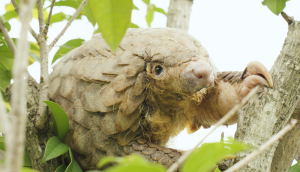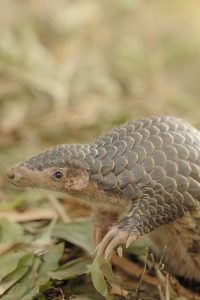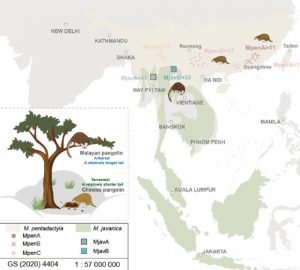World Pangolin Day: Protecting the world’s most trafficked mammal with genomics
Today is World Pangolin Day! To celebrate the occasion GigaScience presents a new article, adding two chromosome-scale genome sequences and in-depth genomic analyses.
Pangolins are cute, but the reason why it’s important to draw regular attention to these scaly mammals is more sober: Pangolins are the most trafficked wild mammals in the world, with more than 900,000 poached in the past two decades. “Traditional medicine” is largely to blame for the serious situation: Pangolin meat and scales are traded at high value. This, and habitat loss, has pushed many pangolin species to the brink of extinction.
Two species, the Malayan pangolin (Manis javanica) and the Chinese pangolin (Manis pentadactyla), are under acute survival pressure. These species have been listed as critically endangered on the Red List of the International Union for Conservation of Nature (IUCN) since 2014.

A spotlight on extinction risks
World Pangolin day is observed on the third Saturday of February, and as it happened, we had a paper in our publication pipeline that we could release just in time today to mark the occasion. This is not the first time the scaly mammals appear in GigaScience though. Already back in 2016 we had published genomic analyses of two pangolin species, using (at the time) cutting-edge optical mapping methods to track stuctural genome variations.
Along similar lines, the new research paper published today showcases the utility of the now state-of-the-art chromosome-scale genomes for population genomic work. The paper also puts a spotlight on the genetic vulnerabilities and extinction risks for Malayan and Chinese pangolin species. The study was a collaborative effort of Chinese scientists involving Yan Hua’s team from the Pangolin Conservation Research Center of the National Forestry and Grassland Administration, Tianming Lan’s team from Northeast Forestry University, and Qiye Li at BGI-Shenzhen. This work is part of the many conservation genomics projects carried out at the College of Wildlife and Protected Area at Northeast Forestry University in Harbin, and we recently visited Tianming (also author of the recent Oriental stork genome paper covered in GigaBlog) and were shown around his impressive lab there.

Lead author Prof Tianming Lan at the College of Wildlife and Protected Area of Northeast Forestry University.
Two high-quality pangolin genomes
 The starting point for their analyses was generating chromosome-scale genome sequences of the Chinese and Malayan pangolin species, at a significantly higher resolution than what is currently available. Having such high quality data in the form of a nearly gapless chromosome-scale sequence is invaluable for obtaining indicators of genetic health. For this, the analyses carried out included looking into genetic diversity estimates, the level of inbreeding and the mutational load in different populations.
The starting point for their analyses was generating chromosome-scale genome sequences of the Chinese and Malayan pangolin species, at a significantly higher resolution than what is currently available. Having such high quality data in the form of a nearly gapless chromosome-scale sequence is invaluable for obtaining indicators of genetic health. For this, the analyses carried out included looking into genetic diversity estimates, the level of inbreeding and the mutational load in different populations.
Specifically, the GigaScience authors used their high quality data as a reference point, along with previously released genomic data from 37 Chinese pangolin and 72 Malayan pangolin individuals, to re-evaluate the conservation genetic status of five pangolin populations. They found that the overall genetic diversity was surprisingly high— which is a positive sign for the genetic health of a population; but, their fine-grained analysis showed that some of these populations are at higher risk of extinction than the others.
Threatened populations
Based on the genetic data for one Pangolin population, the scientists ascertained that this population had suffered a much faster and sharper population decline within the past 10,000 years compared with the other populations in their study. Additionally, other genetic parameters in their study indicated this population in particular was at a very high risk extinction.

Adding to this, their analysis of a pangolin specimen from Taiwan revealed similarly distressing data. Future work is required to solidify the extent to which specific pangolin populations are at extinction risk due to serious survival pressures. The research data also indicate that further studies on the differences between the localities of these populations should receive more attention as they have the ability to aid in guiding the genetic rescue efforts that are already underway.
Rescue efforts
In addition to habitat protection and the fight against poaching and trafficking, breeding and rewilding efforts will help to rescue the Chinese and Malayan pangolin, Professor Tianming Lan explains: “The Chinese government has built a breeding center for the conservation of both Chinese and Malayan pangolins and has developed an artificial breeding and reproduction program. With the assistance of this data, we can better evaluate the genetic rescue strategies for wild populations by rewilding and releasing these captive individuals in the future.”
References:
Lan T; Tian Y; Shi M; Liu B; Lin Y; Xia Y; Ma Y; Kumar SS; Wang Q; Li J; Chen J; Hou F; Yin C; Wang K; Fu Y; Que T; Liu W; Liu H; Li H; Hua Y. Enhancing inbreeding estimation and global conservation insights through chromosome-level assemblies of the Chinese and Malayan pangolin. GigaScience. 2025 https://doi.org/10.1093/gigascience/giaf003
Huang Zhihai, Xu Jiang, Xiao Shuiming, Liao Baosheng, Gao Yuan, Zhai Chaochao, Qiu Xiaohui, Xu Wen, Chen Shilin, Comparative optical genome analysis of two pangolin species: Manis pentadactyla and Manis javanica. GigaScience. 2016 giw001, https://doi.org/10.1093/gigascience/giw001